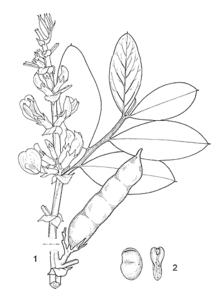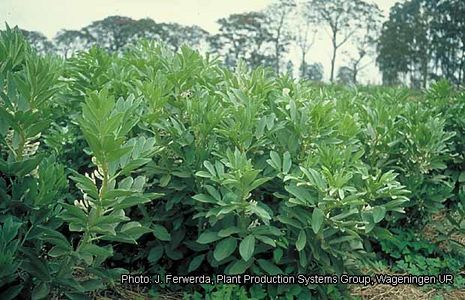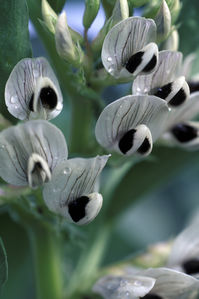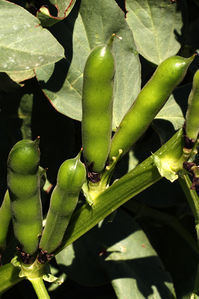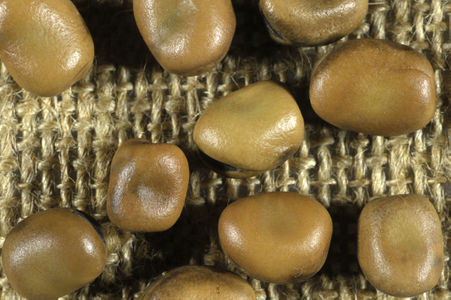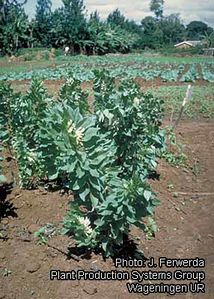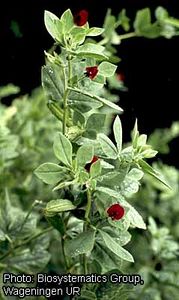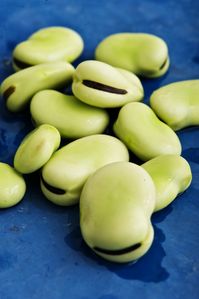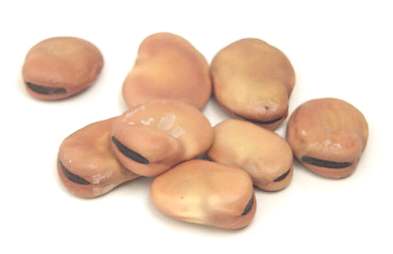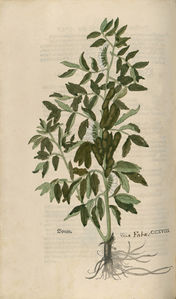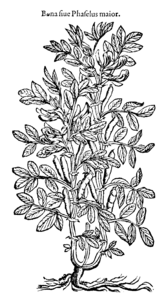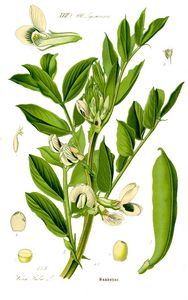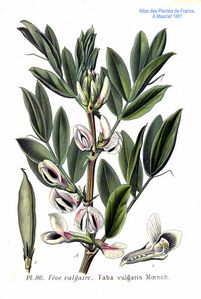Vicia faba
Vicia faba L.
| Ordre | Fabales |
|---|---|
| Famille | Fabaceae |
| Genre | Vicia |
2n =
Origine : inconnue
sauvage ou cultivé
| Français | fève |
|---|---|
| Anglais | broad bean, faba bean |
- graines consommées fraîches ou sèches (en légume sec)
- jeunes gousses consommées parfois comme légume
- feuilles utilisées pour emballer des aliments
- fourrage et protéagineux
- médicinal
Sommaire
Description
- plante herbacée annuelle de 30-80 cm, dressée, robuste
- feuilles à 1-3 paires de folioles ovales, entières
- vrille courte et simple
- stipules larges, dentées, tachées
- fleurs blanches à ailes noires, grandes, 2-5 en petites grappes brièvement pédonculées, bien plus courtes que la feuille
- calice à dents inégales, les 2 supérieures courtes et conniventes
- gousses longues de 10 à 20 cm, renflées, charnues, dressées
- graines ovales-comprimées, à hile linéaire-oblong.
Noms populaires
| français | fève, féverole, fèvette ; fève de(s) marais (Belgique) ; gourgane (Canada) |
| anglais | faba bean, broad bean, horse bean, field bean, tick bean |
| allemand | Ackerbohne, Pferdebohne, Puffbohne |
| néerlandais | tuinboon, paardeboon |
| italien | fava |
| espagnol | haba |
| catalan | favera / fava |
| portugais | faveira / fava |
| bulgare | бакла - bakla |
| arabe | bāqilā, fūl |
| chinois | 蚕豆 - can dou (Flora of China) |
| hindi | bāklā |
| Indonésie | kacang babi (PROSEA) |
| Thailande | thua yang (PROSEA) |
| Birmanie | sandusi (PROSEA) |
- Voir les noms dans toutes les langues européennes
- Voir les noms de la Flore populaire d'Eugène Rolland
- Voir les noms néerlandais tuinboon et veldboon de Plantennamen in de Nederlandse Dialecten (PLAND)
- Voir l'étymologie de Faba
Classification
Vicia faba L. (1753)
synnyme :
- Faba bona Medik. (1787)
Cultivars
Histoire
Bona siue Phaselus maior (Dodoens, Pemptades, 1583)
Usages
- Voir les Plantes médicinales de Cazin (1868)
Vicia pliniana (Trab.) Murat., earlier proposed as wild, presumably ancestral form from Algeria represents however obviously a primitive cultivated race from the Maghreb. One of the most important grain legumes of extra-tropical zones, cultivated in most of the temperate, warm-temperate and subtropical countries, especially in the Mediterranean area, Europe, South-west, Middle and E Asia, E Africa and Latin America; main producers are China, Ethiopia, Egypt, several S European countries and Brazil. Mature seeds are an important protein source of the daily diet in Mediterranean, African and Asiatic countries; they are used for human nutrition as pulse, for soups and porridge, the seed flour as admixture for bread making, young seeds however as vegetable (mostly from large-grained varieties); in many areas nowadays seeds are preferently used for feeding live-stock. Plants are used as green manure (Italy) or for silage (North America). In Asia and Europe a considerable loss of acreage could be noticed in the last decades, mostly due to large imports of oilseed cakes. Faba bean is one of the principal pulses of Old World agriculture. Prehistoric neolithic remains are known from the 7th mill. in Israel, much later since the 4rd mill. from Near East, W Mediterranean, S and Central European countries. These findings refer only to the small-grained groups of the species. The crop came to E Asia presumably only in the late medieval time (13th cent.), here and later to the Americas mainly large-grained accessions were introduced. Since long times intensive breeding programs had been established for the improvement of faba beans, mainly in Europe, N and E Africa, W and E Asia, heterosis breeding and synthetic varieties are recent topics and especially in Europe white-flowering and tannin-free cultivars are achieved. The domestication of the faba bean took place apparently in the Near Eastern-E Mediterranean region. No wild progenitor is known, the phenotypically similar taxa of the sect. Narbonensis are obviously the result of parallel evolution. RFLP data suggest a closer link of V. faba to species of sect. Peregrinae Kupicha. The large-grained groups of the broad bean are phylogenetically younger, not recorded before the end of the 1st mill. AD. Vicia faba is cultivated in hundreds of cultivars and local races, it is extremely variable, a primary centre of variation (the small-grained groups) is located in SW Asia, a secondary one (large-grained groups) in Mediterranean and W European region. Leaf, stem, flower, and especially seed and pod characters vary immensely. In the following a simplified infraspecific classification is proposed; based upon seed and pod shape and sizes, many transitional forms occur:
- minor : Small-grained forms. Sometimes opposed as subsp. minor (Peterm. em. Harz) Rothm. to the type subspecies with larger grains. This rank seems however not justified. The same is true for the primitive forms from the frontier region between NW-India, SE-Tibet and N-Pakistan which are recognized as V. faba ssp. paucijuga by several authors, they represent however merely extreme accessions of the variation amplitude of the variety. If they are really the phylogenetically most ancestral strains of all cultivated varieties of the faba bean needs to be studied. The var. minor (pigeon or tick bean) is grown over all the area of the species, however originally not in E Asia, and only rarely in Latin America. To this variety belong also prehistoric specimens of the species, sometimes named V. faba celtica nana Heer. Nowadays the cultivars and local races are grown mostly for forage, as green manure or for silage, but it is still a food plant in N and NE Africa and in W Asia.
- faba : Large, flat seeds. Cultivated mainly in the Mediterranean region, in W Europe, SW Asia (to Afghanistan), E Asia, Latin America, more rarely in Central and E Europe and North America. Used mostly for human food, especially var. faba as vegetable for the young seeds. Known only since historical times. Further species of Vicia had been used in cultivation trials or recommended in several countries and may have been even cultivated temporarily and locally as forage plant. This is true e.g. for V. noëna Reut.ex Boiss., (doubtfully recorded as forage plant from Syria), V. lutea L., (both sect. Hypechusa) (perhaps formerly grown in N Italy), V. biennis L., (sect. Volutae Kupicha) (recommended already in the 19th century), V. melanops Sibth. & Sm. and V. hyrcanica Fisch. & C.A. Mey. (both sect. Hypechusa) (recently recommended).
Dans les Balkans, les feuilles servent à envelopper des boulettes de viande, de riz ou de boulgour, appelées sarma. (Dogan et al., 2015, 2017).
Références
- Chauvet, Michel, 2018. Encyclopédie des plantes alimentaires. Paris, Belin. 880 p. (p. 415)
- Dambourney, Louis-Alexandre, 1786. Recueil de procédés et d'expériences sur les teintures solides que nos végétaux indigènes communiquent aux laines & aux lainages. Paris, De l'imprimerie de Ph.-D. Pierres, premier imprimeur ordinaire du roi. 407 p. Voir sur Pl@ntUse
- Dogan, Yunus et al., 2015. Of the importance of a leaf: The ethnobotany of sarma in Turkey and the Balkans. J. Ethnobiol. & Ethnomed., 11-26. doi : 10.1186/s13002-015-0002-x
- Schilperoord, Peer,. Plantes cultivées en Suisse – La fève commune des champs. DOI: 10.22014/97839524176-e4.
- Version allemande : Kulturpflanzen in der Schweiz – Ackerbohne. DOI: 10.22014/97839524176-e3
Liens
- BHL
- FAO Ecocrop
- Feedipedia
- Flora of China
- GRIN
- IPNI
- Mansfeld
- Moerman, Native American Ethnobotany
- Multilingual Plant Name Database
- NewCrop Purdue
- Plant List
- Plants for a future
- Plants of the World Online
- PROSEA sur Pl@ntUse
- PROTA sur Pl@ntUse
- TAXREF
- Tela Botanica
- Useful Tropical Plants Database
- Wikipédia
- World Flora Online

